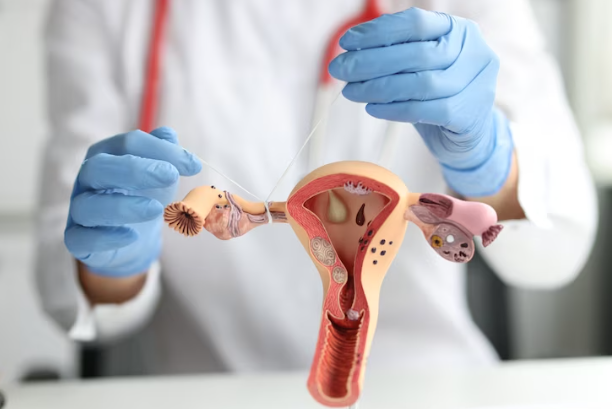Services We offer
- Caesarean Section
- Laparoscopic Surgery
- Laparoscopic Surgery in Infertility
- Hysteroscopic Surgery
- Infertility
- Laparoscopic Creation of Neovagina
- High Risk Pregnancy
- Laparoscopic Tubal Recanalization
- Hysterectomy
- Myomectomy
- Endometriosis
- Diagnostic Laparoscopy
- Urogynaecology
- Vaginal Surgery
- Caesarean Delivery
- Tubal Block Surgery
- Bad Obstetric History(BOH)
- Normal Delivery

Tubal Block Surgery
SURGERY OVERVIEW
A fallopian tube blockage typically prevents successful passage of the egg camera.gif to the sperm, or the fertilized egg to the uterus. Surgery can be used to try to correct this common cause of infertility. The specific type of surgery depends on the location and extent of the fallopian tube blockage.
Some tubal procedures can be done using microsurgical techniques, either during open abdominal surgery or using laparoscopy through a small incision. The surgeon must have special training and expertise in microsurgery techniques and/or laparoscopy. This general overview describes the most common tubal procedures.
Tubal reanastomosis typically is used to reverse a tubal ligation or to repair a portion of the fallopian tube damaged by disease. The blocked or diseased portion of the tube is removed, and the two healthy ends of the tube are then joined. This procedure usually is done through an abdominal incision (laparotomy), but some specialists can do this procedure using laparoscopy.
Salpingectomy, or removal of part of a fallopian tube, is done to improve in vitro fertilization (IVF) success when a tube has developed a buildup of fluid (hydrosalpinx). Hydrosalpinx makes it half as likely that an IVF procedure will succeed.1 Salpingectomy is preferred over salpingostomy for treating a hydrosalpinx before IVF.
Salpingostomy is done when the end of the fallopian tube is blocked by a buildup of fluid (hydrosalpinx). This procedure creates a new opening in the part of the tube closest to the ovary. But it is common for scar tissue to regrow after a salpingostomy, reblocking the tube.
Fimbrioplasty may be done when the part of the tube closest to the ovary is partially blocked or has scar tissue, preventing normal egg pickup. This procedure rebuilds the fringed ends of the fallopian tube.
For a tubal blockage next to the uterus, a nonsurgical procedure called selective tubal cannulation is the first treatment of choice. Using fluoroscopy or hysteroscopy to guide the instruments, a doctor inserts a catheter, or cannula, through the cervix and the uterus camera.gif and into the fallopian tube.
WHAT TO EXPECT AFTER SURGERY
After open abdominal surgery, there usually is a 2- to 3-day hospital stay. Antibiotics may be given to prevent infection. A woman usually can return to work in 4 to 6 weeks, depending on the extent of surgery, the nature of her work, and her overall health and stamina.
After laparoscopic surgery, there is a brief hospital stay. A woman’s return to daily activities can take a few days to a couple of weeks, depending on the type of procedure.
WHY IT IS DONE
Fallopian tube surgery may be done if:
• Hysterosalpingography shows blocked fallopian tubes.
• A blocked fallopian tube has a buildup of fluid (hydrosalpinx).
• You want to have a tubal ligation reversed.
HOW WELL IT WORKS
The success of a fallopian tube procedure depends in part on the location and extent of the blockage, as well as the presence or absence of other fertility problems.
• Clearing a blockage in the part of the tube closest to the uterus (proximal occlusion) is more likely to be successful. These blockages often are functional (such as a mucus plug) rather than structural (such as scarring or other obstruction). Up to 60 out of 100 women with proximal occlusion have been reported to have successful pregnancies after tubal surgery.
• From 20 to 30 out of 100 women with a blockage near the end of the fallopian tube have had successful pregnancies after tubal surgery.
• The amount of fallopian tube that remains after surgery is critical to the function of the tube. If a large part of the tube must be removed to eliminate blockage, the likelihood of pregnancy after surgery is reduced.
The success of a sterilization reversal is influenced by the tubal ligation method used, by how recently the tubal ligation was done, and by the woman’s age-related fertility.
Other conditions that affect the success of surgery include not only whether the woman has scar tissue (adhesions) in her pelvis and whether she has other diseases in the pelvic area but also the surgeon’s level of skill and experience.
RISKS
Risks of fallopian tube surgery include:
• Pelvic infection.
• Scar tissue (adhesions) forming on the reproductive organs, causing them to bind to the abdominal wall or to other organs.
• Increased risk of tubal (ectopic) pregnancy after surgery.
WHAT TO THINK ABOUT
Some fallopian tube problems can be treated with more than one type of surgery or procedure. Ask your doctor for his or her success rates (birth of a healthy baby), as well as national success rates, for any procedure you are considering.
Hysterosalpingography may be done 3 to 6 months after surgery, to check whether the tubes have been opened.
If you do not become pregnant within 12 to 18 months following surgery, your doctor may do a laparoscopy to check the condition of your fallopian tubes or may refer you for in vitro fertilization (IVF).
When successful, a fallopian tube procedure can enable a woman to have more than one pregnancy without ongoing fertility treatment and repeated use of IVF.
Moreover, if you want infertility specialist in Kolkata, Dr. Sankar DasMahapatra is here to help you.